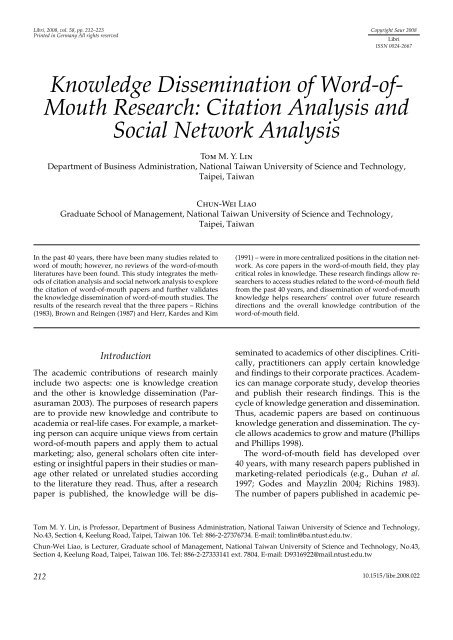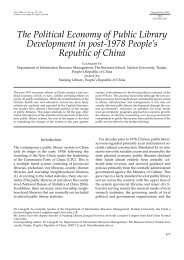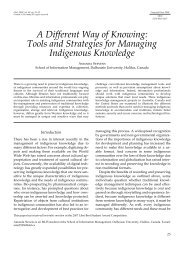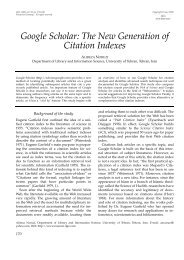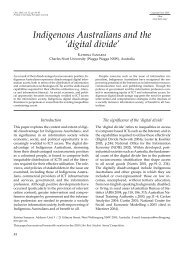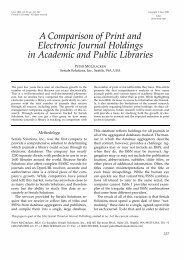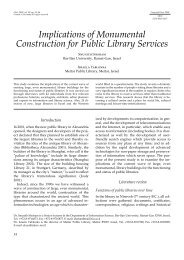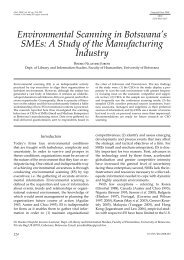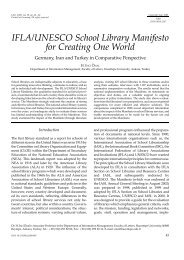Knowledge Dissemination of Word-of- Mouth Research ... - Libri
Knowledge Dissemination of Word-of- Mouth Research ... - Libri
Knowledge Dissemination of Word-of- Mouth Research ... - Libri
You also want an ePaper? Increase the reach of your titles
YUMPU automatically turns print PDFs into web optimized ePapers that Google loves.
<strong>Libri</strong>, 2008, vol. 58, pp. 212–223<br />
Printed in Germany All rights reserved<br />
<strong>Knowledge</strong> <strong>Dissemination</strong> <strong>of</strong> <strong>Word</strong>-<strong>of</strong>-<br />
<strong>Mouth</strong> <strong>Research</strong>: Citation Analysis and<br />
Social Network Analysis<br />
Tom M. Y. Lin<br />
Department <strong>of</strong> Business Administration, National Taiwan University <strong>of</strong> Science and Technology,<br />
Taipei, Taiwan<br />
Chun-Wei Liao<br />
Graduate School <strong>of</strong> Management, National Taiwan University <strong>of</strong> Science and Technology,<br />
Taipei, Taiwan<br />
In the past 40 years, there have been many studies related to<br />
word <strong>of</strong> mouth; however, no reviews <strong>of</strong> the word-<strong>of</strong>-mouth<br />
literatures have been found. This study integrates the methods<br />
<strong>of</strong> citation analysis and social network analysis to explore<br />
the citation <strong>of</strong> word-<strong>of</strong>-mouth papers and further validates<br />
the knowledge dissemination <strong>of</strong> word-<strong>of</strong>-mouth studies. The<br />
results <strong>of</strong> the research reveal that the three papers – Richins<br />
(1983), Brown and Reingen (1987) and Herr, Kardes and Kim<br />
Introduction<br />
The academic contributions <strong>of</strong> research mainly<br />
include two aspects: one is knowledge creation<br />
and the other is knowledge dissemination (Parasuraman<br />
2003). The purposes <strong>of</strong> research papers<br />
are to provide new knowledge and contribute to<br />
academia or real-life cases. For example, a marketing<br />
person can acquire unique views from certain<br />
word-<strong>of</strong>-mouth papers and apply them to actual<br />
marketing; also, general scholars <strong>of</strong>ten cite interesting<br />
or insightful papers in their studies or manage<br />
other related or unrelated studies according<br />
to the literature they read. Thus, after a research<br />
paper is published, the knowledge will be dis-<br />
Copyright Saur 2008<br />
<strong>Libri</strong><br />
ISSN 0024-2667<br />
(1991) – were in more centralized positions in the citation network.<br />
As core papers in the word-<strong>of</strong>-mouth fi eld, they play<br />
critical roles in knowledge. These research fi ndings allow researchers<br />
to access studies related to the word-<strong>of</strong>-mouth fi eld<br />
from the past 40 years, and dissemination <strong>of</strong> word-<strong>of</strong>-mouth<br />
knowledge helps researchers’ control over future research<br />
directions and the overall knowledge contribution <strong>of</strong> the<br />
word-<strong>of</strong>-mouth fi eld.<br />
seminated to academics <strong>of</strong> other disciplines. Critically,<br />
practitioners can apply certain knowledge<br />
and fi ndings to their corporate practices. Academics<br />
can manage corporate study, develop theories<br />
and publish their research fi ndings. This is the<br />
cycle <strong>of</strong> knowledge generation and dissemination.<br />
Thus, academic papers are based on continuous<br />
knowledge generation and dissemination. The cycle<br />
allows academics to grow and mature (Phillips<br />
and Phillips 1998).<br />
The word-<strong>of</strong>-mouth fi eld has developed over<br />
40 years, with many research papers published in<br />
marketing-related periodicals (e.g., Duhan et al.<br />
1997; Godes and Mayzlin 2004; Richins 1983).<br />
The number <strong>of</strong> papers published in academic pe-<br />
Tom M. Y. Lin, is Pr<strong>of</strong>essor, Department <strong>of</strong> Business Administration, National Taiwan University <strong>of</strong> Science and Technology,<br />
No.43, Section 4, Keelung Road, Taipei, Taiwan 106. Tel: 886-2-27376734. E-mail: tomlin@ba.ntust.edu.tw.<br />
Chun-Wei Liao, is Lecturer, Graduate school <strong>of</strong> Management, National Taiwan University <strong>of</strong> Science and Technology, No.43,<br />
Section 4, Keelung Road, Taipei, Taiwan 106. Tel: 886-2-27333141 ext. 7804. E-mail: D9316922@mail.ntust.edu.tw<br />
212<br />
10.1515/libr.2008.022
iodicals has also increased year after year. Nevertheless,<br />
in the past literature, no formal research<br />
has explored knowledge dissemination <strong>of</strong><br />
word-<strong>of</strong>-mouth, and only rare studies have been<br />
conducted on citation analysis <strong>of</strong> word-<strong>of</strong>-mouth<br />
papers. The periodicals <strong>of</strong> other fi elds frequently<br />
citing word-<strong>of</strong>-mouth papers and paper citations<br />
among researchers <strong>of</strong> the word-<strong>of</strong>-mouth fi eld<br />
raise very interesting and important issues for<br />
word-<strong>of</strong>-mouth researchers and practitioners,<br />
since they could thus understand the application<br />
<strong>of</strong> word-<strong>of</strong>-mouth studies to directing future<br />
research. The exploration <strong>of</strong> this research could<br />
completely describe word-<strong>of</strong>-mouth fi eld studies<br />
over the past 40 years, supplement the gap in<br />
literature and refl ect on the contributions <strong>of</strong> word<strong>of</strong>-mouth<br />
studies.<br />
This research had three purposes: 1) to use<br />
citation analysis to explore the citation <strong>of</strong> word<strong>of</strong>-mouth<br />
papers and the sequence <strong>of</strong> citations; 2)<br />
based on the Social Science Citation Index (SSCI)<br />
and the Science Citation Index (SCI) value, to<br />
analyze periodicals citing the highest number <strong>of</strong><br />
WOM papers; 3) using social network analysis<br />
to explore paper citation among word-<strong>of</strong>-mouth<br />
researchers. We wanted to report the results and<br />
discussion <strong>of</strong> citation analysis and social network<br />
analysis <strong>of</strong> word-<strong>of</strong>-mouth papers <strong>of</strong> the past 40<br />
years. Through the analytical results, we hoped<br />
to provide researchers with access to the development<br />
and knowledge diffusion <strong>of</strong> word-<strong>of</strong>-mouth<br />
research papers <strong>of</strong> the past 40 years, which would<br />
be <strong>of</strong> considerable help to researchers’future research<br />
directions and overall knowledge contributions.<br />
The research methods adopted are described<br />
in detail and the research results are discussed at<br />
the end <strong>of</strong> the paper.<br />
Literature review<br />
<strong>Word</strong>-<strong>of</strong>-mouth research issues are extremely<br />
broad, such as word-<strong>of</strong>-mouth advertising issues<br />
(e.g., Hogan, Lemon and Libai 2004), word-<strong>of</strong>mouth<br />
communication issues (e.g., Godes and<br />
Mayzlin 2004), and electronic word-<strong>of</strong>-mouth issues<br />
(e.g., Bickart and Schindler 2002; Dellarocas<br />
2003). This research will review the most commonly<br />
cited word-<strong>of</strong>-mouth papers in the past<br />
through the view <strong>of</strong> knowledge dissemination.<br />
<strong>Knowledge</strong> <strong>Dissemination</strong> <strong>of</strong> <strong>Word</strong>-<strong>of</strong>-<strong>Mouth</strong> <strong>Research</strong><br />
Most cited word-<strong>of</strong>-mouth research before the<br />
1970s<br />
The word-<strong>of</strong>-mouth papers most cited in early<br />
times primarily explored issues related to advertising<br />
and innovations. Dichter (1966) conducted<br />
in-depth interviews <strong>of</strong> 255 consumers in 24 localities<br />
<strong>of</strong> the U.S. and explored consumers’ psychological<br />
aspects for communicating by word-<strong>of</strong>mouth.<br />
Dichter also applied the research fi ndings<br />
to the advertising <strong>of</strong> products. Engel, Kegerreis<br />
and Blackwell (1969) interviewed 249 customers<br />
on the fi rst day <strong>of</strong> the opening <strong>of</strong> a new automobile<br />
diagnosis centre in Columbus, Ohio, U.S. and<br />
tracked the post-trial behaviour <strong>of</strong> these fi rst-time<br />
users to confi rm the innovators’ word-<strong>of</strong>-mouth<br />
communication. The research results also showed<br />
that the innovators tended to inquire about opinions<br />
<strong>of</strong> new things and voluntarily communicated<br />
news related to innovations.<br />
In addition, Sheth (1971) believed that word-<strong>of</strong>mouth<br />
played an important role in the diffusion<br />
<strong>of</strong> innovations. The targets discussed in previous<br />
literature were mostly products with high risk<br />
(Rogers 1962). This meant that word-<strong>of</strong>-mouth<br />
was less important for products <strong>of</strong> less radical or<br />
low-risk innovations. However, he explored stainless<br />
steel blades, which were regarded as low-risk<br />
products. He interviewed over 900 users and<br />
confi rmed that word-<strong>of</strong>-mouth also played an important<br />
role in the diffusion <strong>of</strong> low-risk products.<br />
Dodson and Muller (1978) validated the product<br />
diffusion process model developed by previous<br />
studies (e.g. Nerlove and Arrow 1962; Bass 1969)<br />
and integrated several theories and models from<br />
economics and marketing to develop a general<br />
diffusion model. Since the model included advertising,<br />
word-<strong>of</strong>-mouth and repurchasing effi cacy,<br />
it revealed more effects.<br />
In the area <strong>of</strong> industrial markets, Martilla (1971)<br />
indicated that industrial marketing persons did<br />
not value advertising and other impersonal communications.<br />
The main reasons for their attitudes<br />
were that in marketing for industrial markets, the<br />
application <strong>of</strong> communication and diffusion theory<br />
was not examined. Whether word-<strong>of</strong>-mouth<br />
communication suitable for consumer product<br />
purchasing could be applied to industrial markets<br />
was uncertain. He therefore investigated 106 fi rms<br />
using interviews and written questionnaires regarding<br />
their actual purchasing <strong>of</strong> paper. The re-<br />
213
Tom M. Y. Lin and Chun-Wei Liao<br />
search showed that in industrial markets, word<strong>of</strong>-mouth<br />
communication in the fi rms revealed<br />
signifi cant infl uences in the later period <strong>of</strong> purchasing.<br />
In addition, compared with other buying<br />
infl uences, opinion leaders in the fi rms were more<br />
likely to expose themselves through impersonal<br />
information.<br />
Most cited word-<strong>of</strong>-mouth research<br />
<strong>of</strong> the 1980s<br />
Marketing academics in the 1970s emphasized the<br />
importance <strong>of</strong> consumers’ satisfaction and rare<br />
studies existed on consumers’ dissatisfaction reaction.<br />
Richins (1983) used in-depth interviews and<br />
open-ended questionnaire surveys to explore the<br />
correlation between the possible reactions <strong>of</strong> consumers<br />
to dissatisfying experiences and defi ned<br />
consumer variables for dissatisfaction reactions.<br />
The research validated that the nature <strong>of</strong> dissatisfaction,<br />
consumers’ attributions <strong>of</strong> blame for their<br />
dissatisfaction and perceptions <strong>of</strong> the complaint<br />
situation were connected to dissatisfaction reactions.<br />
The relationship could be applied to a range<br />
<strong>of</strong> product classes and the research fi ndings in this<br />
paper thereafter became the most cited literature<br />
in studies related to word-<strong>of</strong>-mouth.<br />
Mahajan, Muller and Kerin (1984) proposed a<br />
model to explain the infl uence <strong>of</strong> negative word<strong>of</strong>-mouth<br />
in new product diffusion processes,<br />
since general diffusion theory assumed that “individuals’<br />
use experience <strong>of</strong> products is communicated<br />
by positive word-<strong>of</strong>-mouth.” However,<br />
in fact, the content <strong>of</strong> word-<strong>of</strong>-mouth could be<br />
positive, negative or neutral; the force <strong>of</strong> negative<br />
word-<strong>of</strong>-mouth could even be more than positive<br />
word-<strong>of</strong>-mouth. The author also used university<br />
students’ movie watching experience as an example<br />
to test the model. The research showed that<br />
negative word-<strong>of</strong>-mouth played a dominant role<br />
in product diffusion theory.<br />
In addition, Brown and Reingen (1987) indicated<br />
that a close relationship existed between word<strong>of</strong>-mouth<br />
communication and interpersonal networks.<br />
They used the view <strong>of</strong> interpersonal networks<br />
to examine the roles <strong>of</strong> relationship intensity<br />
and homogeneity in word-<strong>of</strong>-mouth processes.<br />
The research found that weak ties in an interpersonal<br />
network had a critical connecting function.<br />
In the broader social system, information can be<br />
connected to different sub-communities in socie-<br />
214<br />
ty through weak ties. Compared with weak ties,<br />
when strong ties between communicators and<br />
receivers or two parties were homogeneous, the<br />
word-<strong>of</strong>-mouth process was more enlivened. In<br />
addition, compared with information through<br />
weak ties, information through strong ties was<br />
more infl uential and more <strong>of</strong>ten used as the information<br />
sources <strong>of</strong> the related products.<br />
Most cited word-<strong>of</strong>-mouth research<br />
after 1990<br />
Past studies related to communication showed<br />
that communicators’ traits (such as similarity,<br />
credibility and trustworthiness) could infl uence<br />
word-<strong>of</strong>-mouth communication. Herr, Kardes and<br />
Kim (1991) pointed out that information vividness<br />
would apparently infl uence the effects <strong>of</strong><br />
word-<strong>of</strong>-mouth. Thus, they used two experiments<br />
to explore the mediation <strong>of</strong> WOM effects on persuasion<br />
and confi rmed other possible moderating<br />
variables. They found that the infl uences <strong>of</strong><br />
word-<strong>of</strong>-mouth communication and information<br />
with specifi c properties on product assessments<br />
actually existed. The result <strong>of</strong> the fi rst experiment<br />
showed that face-to-face word-<strong>of</strong>-mouth communication<br />
was more convincing than print communication.<br />
The result <strong>of</strong> the second experiment<br />
showed that although a powerful word-<strong>of</strong>-mouth<br />
effect could be confi rmed, it could be reduced or<br />
eliminated by the impression <strong>of</strong> target brands or<br />
extremely powerful negative messages.<br />
Blodgett, Granbois and Walters (1993) believed<br />
that the negative word-<strong>of</strong>-mouth behaviour <strong>of</strong> consumers’<br />
complaints and the possibility <strong>of</strong> re-buying<br />
were related to consumers’ perceived justice.<br />
They investigated employees <strong>of</strong> two universities<br />
(a Midwestern university and a university in the<br />
mid-South) through questionnaires. They collected<br />
201 total samples and managed the analysis<br />
through a model constructed by LISREL. The<br />
research results pointed to the importance <strong>of</strong> customer<br />
service and customer satisfaction. Particularly,<br />
the costs <strong>of</strong> maintaining satisfi ed existing<br />
consumers were lower than those <strong>of</strong> developing<br />
new clients.<br />
Ellison and Fudenberg (1995) used the original<br />
word-<strong>of</strong>-mouth communication model to validate<br />
the relationship between word-<strong>of</strong>-mouth communication<br />
and social learning. The research found<br />
that word-<strong>of</strong>-mouth communication could lead
to effective social learning. When communication<br />
media were completely restricted, social learning<br />
was the most effective method.<br />
Selection <strong>of</strong> papers<br />
Method<br />
This research treated the word-<strong>of</strong>-mouth research<br />
papers published in social science and science periodicals<br />
before 2004 and focused on SSCI and SCI<br />
periodicals. There are two main reasons for this<br />
approach. First, the signifi cance <strong>of</strong> literature citation<br />
was examined. The newly published papers<br />
might reveal less signifi cant citation in a certain<br />
group. Second, the consistency <strong>of</strong> paper quality<br />
was examined. Thousands <strong>of</strong> periodicals in the social<br />
science and science literature exist, and their<br />
quality might vary. The quality <strong>of</strong> papers published<br />
in SSCI and SCI periodicals was affi rmed<br />
and many institutions treated the papers published<br />
in these periodicals as the criteria for assessing<br />
researchers’ published papers.<br />
The selection <strong>of</strong> word-<strong>of</strong>-mouth research papers<br />
was based on electronic and manual searching<br />
and the researcher attempted a complete search<br />
for word-<strong>of</strong>-mouth research papers. This research<br />
used three databases (ABI/INFORM , Web <strong>of</strong><br />
Science and EBSCO) to search for papers related<br />
to word-<strong>of</strong>-mouth studies. The search was conducted<br />
in January and February 2006 and was restricted<br />
to papers with “word-<strong>of</strong>-mouth or WOM”<br />
in their titles, because word-<strong>of</strong>-mouth is probably<br />
the most central topic covered in those papers.<br />
This searching method has been generally used<br />
in studies <strong>of</strong> other fi elds (e.g., Moore et al. 2005;<br />
Zou 2005). Although this kind <strong>of</strong> restriction might<br />
eliminate or exclude some papers, it ensures that<br />
the papers searched were actually about a study<br />
related to the word-<strong>of</strong>-mouth fi eld. After electronic<br />
searching and manual confi rmation <strong>of</strong> the<br />
relationship between the papers and the academic<br />
study <strong>of</strong> word-<strong>of</strong>-mouth, 114 papers were fi nally<br />
confi rmed.<br />
After reconfi rmation, only 69 <strong>of</strong> the above papers<br />
were published in SSCI or SCI periodicals.<br />
Essentially, these papers were allocated to a study<br />
related to the word-<strong>of</strong>-mouth fi eld. The research<br />
methods they used included qualitative research<br />
methods such as in-depth interviews and content<br />
analysis, and quantitative research methods<br />
<strong>Knowledge</strong> <strong>Dissemination</strong> <strong>of</strong> <strong>Word</strong>-<strong>of</strong>-<strong>Mouth</strong> <strong>Research</strong><br />
such as surveys and experiments. To collect the<br />
literature needed for the study completely, in addition<br />
to electronic searching, the researchers also<br />
acquired papers from domestic and international<br />
libraries, such as the British Library, through cooperative<br />
library services.<br />
Citation analysis<br />
There are many ways to study knowledge dissemination.<br />
However, this research decided to use<br />
citation analysis. The main reason for this choice<br />
was that mutual citation <strong>of</strong> papers in the periodicals<br />
provided concrete evidence that knowledge<br />
was generated and used. This research performed<br />
the citation analysis in February 2007 and used the<br />
ISI Web <strong>of</strong> <strong>Knowledge</strong> SM database to search for papers<br />
that had cited the 69 word-<strong>of</strong>-mouth papers<br />
that defi ned the scope <strong>of</strong> this research. To capture<br />
the data <strong>of</strong> each citation paper, including authors,<br />
subjects, published periodicals, published time<br />
and the times cited, Micros<strong>of</strong>t Excel s<strong>of</strong>tware was<br />
used to establish a database and analyze citations<br />
by arrangement and screening. The main purpose<br />
<strong>of</strong> the analysis was to understand the citation <strong>of</strong><br />
the word-<strong>of</strong>-mouth papers and the periodicals <strong>of</strong><br />
the fi elds citing the highest number <strong>of</strong> word-<strong>of</strong>mouth<br />
papers.<br />
Social network analysis<br />
Social network analysis was launched as a new<br />
technique in the 1960s (Scott 1991). The focus <strong>of</strong><br />
network analysis was to understand how the characteristics<br />
<strong>of</strong> network structure affected behaviour<br />
(Webster and Morrison 2004). Social network studies<br />
could confi rm the mutual relationships among<br />
the members <strong>of</strong> a community, or information<br />
exchange and understand how knowledge diffusion<br />
functioned through networks. Social network<br />
analysis itself provided quantitative and qualitative<br />
measurements to understand further the relationships<br />
<strong>of</strong> members in a defi nite social network<br />
(Scott 1991). These relationships might include, for<br />
example, the strength <strong>of</strong> the friendship, infl uence,<br />
or patterns <strong>of</strong> communication among members <strong>of</strong><br />
a scientifi c community.<br />
This research explores a corpus <strong>of</strong> word-<strong>of</strong>mouth<br />
literature to access and visualize the<br />
word-<strong>of</strong>-mouth research fi eld. First, we examined<br />
the references <strong>of</strong> each word-<strong>of</strong>-mouth paper to<br />
215
Tom M. Y. Lin and Chun-Wei Liao<br />
Table 1. Citations <strong>of</strong> the <strong>Word</strong>-<strong>of</strong>-<strong>Mouth</strong> Papers (Key to journal abbreviations appears on following page.)<br />
First author Periodical Subject <strong>of</strong> paper WOM<br />
times<br />
cited by<br />
academics<br />
216<br />
Times<br />
cited by<br />
other<br />
Total<br />
citations<br />
Richins (1983) JM Negative <strong>Word</strong>-<strong>of</strong>-<strong>Mouth</strong> by Dissatisfi ed Consumers: A Pilot Study 21<br />
academics<br />
113 134<br />
Herr (1991) JCR Effects <strong>of</strong> <strong>Word</strong>-<strong>of</strong>-<strong>Mouth</strong> and Product-Attribute Information on Persuasion: An<br />
Accessibility-Diagnosticity Perspective<br />
11 76 87<br />
Brown (1987) JCR Social Ties and <strong>Word</strong>-<strong>of</strong>-<strong>Mouth</strong> Referral Behaviour 13 60 73<br />
Ellison (1995) TQJE <strong>Word</strong>-<strong>of</strong>-<strong>Mouth</strong> Communication and Social Learning 3 52 55<br />
Dodson (1978) MNS Models <strong>of</strong> New Product Diffusion through Advertising and <strong>Word</strong>-<strong>of</strong>-<strong>Mouth</strong> 3 49 52<br />
Mahajan (1984) MNS Introduction Strategy for New Products with Positive and Negative <strong>Word</strong>-<strong>of</strong>-<strong>Mouth</strong> 3 37 40<br />
Martilla (1971) JMR <strong>Word</strong>-<strong>of</strong>-<strong>Mouth</strong> Communication in the Industrial Adoption Process 1 31 32<br />
Dichter (1966) HBR How <strong>Word</strong>-<strong>of</strong>-<strong>Mouth</strong> Advertising Works 6 23 29<br />
Blodgett (1993) JR The Effects <strong>of</strong> Perceived Justice on Complainants‘ Negative <strong>Word</strong>-<strong>of</strong>-<strong>Mouth</strong> Behaviour<br />
and Repatronage Intentions<br />
2 26 28<br />
Engel (1969) JM <strong>Word</strong>-<strong>of</strong>-<strong>Mouth</strong> Communication by the Innovator 4 21 25<br />
Sheth (1971) JAR <strong>Word</strong>-<strong>of</strong>-<strong>Mouth</strong> in Low-Risk Innovations 5 19 24<br />
Czepiel (1974) JMR <strong>Word</strong>-<strong>of</strong>-<strong>Mouth</strong> Processes in the Diffusion <strong>of</strong> a Major Technological Innovation 0 22 22<br />
Money (1998) JM Explorations <strong>of</strong> National Culture and <strong>Word</strong>-Of-<strong>Mouth</strong> Referral Behaviour in the<br />
Purchase <strong>of</strong> Industrial Services in the United States and Japan<br />
3 14 17<br />
Bowman (2001) JMR Managing Customer-Initiated Contacts with Manufacturers: The Impact on Share <strong>of</strong><br />
Category Requirements and <strong>Word</strong>-<strong>of</strong>-<strong>Mouth</strong> Behaviour<br />
0 17 17<br />
Higie (1987) JR Types and Amount <strong>of</strong> <strong>Word</strong>-<strong>of</strong>-<strong>Mouth</strong> Communications About Retailers 1 14 15<br />
Holmes (1977) JA Product Sampling and <strong>Word</strong> Of <strong>Mouth</strong> 6 7 13<br />
Dellarocas (2003) MNS The Digitization <strong>of</strong> <strong>Word</strong>-<strong>of</strong>-mouth: Promise and Challenges <strong>of</strong> Online Feedback<br />
Mechanisms<br />
0 13 13<br />
Bone (1995) JBR <strong>Word</strong>-<strong>of</strong>-<strong>Mouth</strong> Effects on Short-term and Long-term Product Judgments 2 10 12<br />
Duhan (1997) JAMS Infl uences on Consumer Use <strong>of</strong> <strong>Word</strong>-<strong>of</strong>-<strong>Mouth</strong> Recommendation Sources 3 9 12<br />
Soderlund (1998) IJSIM Customer Satisfaction and its Consequences on Customer Behaviour Revisited The<br />
Impact <strong>of</strong> Different Levels <strong>of</strong> Satisfaction on <strong>Word</strong>-<strong>of</strong>-<strong>Mouth</strong>, Feedback to the Supplier<br />
and Loyalty<br />
1 10 11<br />
Hartline (1996) JBR Employee Performance Cues in a Hotel Service Environment: Infl uence on Perceived<br />
Service Quality, Value, and <strong>Word</strong>-<strong>of</strong>-<strong>Mouth</strong> Intentions<br />
2 8 10<br />
Corcoran (1980) MLR Most Workers Find Jobs through <strong>Word</strong> <strong>of</strong> <strong>Mouth</strong> 0 9 9<br />
Tapiero (1983) EJOR Stochastic Diffusion Models with Advertising and <strong>Word</strong>-<strong>of</strong>-<strong>Mouth</strong> Effects 0 8 8<br />
Richins (1984) ACR <strong>Word</strong> <strong>of</strong> <strong>Mouth</strong> Communication as Negative Information 2 6 8<br />
Bayus (1985) JAR <strong>Word</strong> <strong>of</strong> <strong>Mouth</strong>: The Indirect Effects <strong>of</strong> Marketing Efforts 3 5 8<br />
Berger (1988) JEBO <strong>Word</strong>-<strong>of</strong>-<strong>Mouth</strong> Reputations in Auto Insurance Markets 0 8 8<br />
File (1994) TSIJ <strong>Word</strong>-<strong>of</strong>-<strong>Mouth</strong> Effects in Pr<strong>of</strong>essional Services Buyer Behaviour 0 8 8<br />
Vettas (1997) IER On the Informational Role <strong>of</strong> Quantities: Durable Goods and Consumers‘ <strong>Word</strong>-<strong>of</strong>-<br />
<strong>Mouth</strong> Communication<br />
0 6 6<br />
Bone (1992) ACR Determinants <strong>of</strong> <strong>Word</strong>-<strong>of</strong>-<strong>Mouth</strong> Communications during Product Consumption 2 3 5<br />
Dye (2000) HBR The Buzz on Buzz 0 5 5<br />
Maxham III (2001) JBR Service Recovery‘s Infl uence on Consumer Satisfaction, Positive <strong>Word</strong>-<strong>of</strong>-<strong>Mouth</strong>, and<br />
Purchase Intentions<br />
0 5 5<br />
Goldenberg (2001) ML Talk <strong>of</strong> the Network: A Complex Systems Look at the Underlying Process <strong>of</strong> <strong>Word</strong>-<strong>of</strong>-<br />
<strong>Mouth</strong><br />
0 5 5<br />
Reingen (1987) ACR A <strong>Word</strong>-<strong>of</strong>-<strong>Mouth</strong> Network 1 3 4<br />
Sundaram (1998) ACR <strong>Word</strong>-<strong>of</strong>-<strong>Mouth</strong> Communications: A Motivational Analysis 1 3 4<br />
Arndt (1968) JAR Selective Processes in <strong>Word</strong> <strong>of</strong> <strong>Mouth</strong> 0 3 3<br />
Wilson (1989) ACR Some Limits on the Potency <strong>of</strong> <strong>Word</strong>-<strong>of</strong>-<strong>Mouth</strong> Information 1 2 3<br />
Dawid (1999) AOR On the Dynamics <strong>of</strong> <strong>Word</strong> <strong>of</strong> <strong>Mouth</strong> Learning with and without Anticipations 0 3 3<br />
Gremler (2001) IJSIM Generating Positive <strong>Word</strong>-<strong>of</strong>-<strong>Mouth</strong> Communication through Customer-Employee<br />
Relationships<br />
1 2 3<br />
Day (1971) JAR Attitude Change, Media and <strong>Word</strong> <strong>of</strong> <strong>Mouth</strong> 1 1 2<br />
Brown (1989) ACR Consumer Complaining and <strong>Word</strong> <strong>of</strong> <strong>Mouth</strong> Activities - Field Evidence 0 2 2<br />
Kennedy (1994) ER <strong>Word</strong>-<strong>of</strong>-<strong>Mouth</strong> Communication and Price as a Signal <strong>of</strong> Quality 0 2 2<br />
Laczniak (2001) JCP Consumers‘ Responses to Negative <strong>Word</strong>-<strong>of</strong>-<strong>Mouth</strong> Communication: An Attributions<br />
Theory Perspective<br />
1 1 2<br />
Grewal (2003) JCP Early-Entrant Advantage, <strong>Word</strong>-<strong>of</strong>-<strong>Mouth</strong> Communication, Brand Similarity, and the<br />
Consumer Decision-Making Process<br />
0 2 2<br />
Derbaix (2003) JEP Inducing <strong>Word</strong>-<strong>of</strong>-<strong>Mouth</strong> by Eliciting Surprise - A Pilot Investigation 0 2 2<br />
Banerjee (2004) GEB <strong>Word</strong>-<strong>of</strong>-<strong>Mouth</strong> Learning 0 2 2<br />
Godes (2004) MS Using Online Conversations to Study <strong>Word</strong>-<strong>of</strong>-<strong>Mouth</strong> Communication 0 2 2<br />
Archer (1994) EJOR A Dynamic Service Quality Cost Model with <strong>Word</strong>-<strong>of</strong>-<strong>Mouth</strong> Advertising 0 1 1<br />
Sundaram (1999) ACR The Role <strong>of</strong> Brand Familiarity on the Impact <strong>of</strong> <strong>Word</strong>-<strong>of</strong>-<strong>Mouth</strong> Communication on<br />
Brand Evaluations<br />
0 1 1<br />
Wirtz (2002) IJSIM The Effects <strong>of</strong> Incentives, Deal Proneness, Satisfaction and Tie Strength on <strong>Word</strong>-<strong>of</strong>-<br />
<strong>Mouth</strong> Behaviour<br />
0 1 1<br />
Brooks (1958) JM „<strong>Word</strong>-<strong>of</strong>-<strong>Mouth</strong>“ Advertising in Selling New Product 1 0 1
Table 2. Top 10 Frequency <strong>of</strong> <strong>Word</strong>-<strong>of</strong>-<strong>Mouth</strong> Papers Cited by Other Fields<br />
Discipline Attribution First authors <strong>of</strong> cited papers Total Percentage%<br />
Richins<br />
(1983)<br />
Herr<br />
(1991)<br />
Brown<br />
(1987)<br />
Ellison<br />
(1995)<br />
Dodson<br />
(1978)<br />
confi rm whether they cited the other 68 papers<br />
selected for this research. Since our target was<br />
to construct a network <strong>of</strong> word-<strong>of</strong>-mouth papers<br />
and the infl uences <strong>of</strong> specifi c papers, we used<br />
the citation relationships among the 69 word-<strong>of</strong>mouth<br />
papers to construct a citation network.<br />
Second, this research used a database constructed<br />
in Micros<strong>of</strong>t Excel to develop a co-citation matrix<br />
<strong>of</strong> word-<strong>of</strong>-mouth papers. We also used network<br />
analysis s<strong>of</strong>tware UCINET and NetDraw (Borgatti,<br />
Everett and Freeman 2002) s<strong>of</strong>tware to manage<br />
the data and describe the strength <strong>of</strong> the relationships<br />
among the 69 papers.<br />
In addition, centrality scores were determined<br />
for each paper. Centrality measures the visibility<br />
or prominence <strong>of</strong> actors in a network at a specifi<br />
c moment in time. For this analysis, centrality<br />
provides a cross-sectional look at the state <strong>of</strong> the<br />
literature as <strong>of</strong> the end <strong>of</strong> 2004. In a network containing<br />
directed ties (e.g., “cites” or “is cited by”),<br />
a distinction can be made between in-degree and<br />
<strong>Knowledge</strong> <strong>Dissemination</strong> <strong>of</strong> <strong>Word</strong>-<strong>of</strong>-<strong>Mouth</strong> <strong>Research</strong><br />
Mahajan<br />
(1984)<br />
out-degree centrality. In-degree centrality measures<br />
the prominence <strong>of</strong> certain papers in terms <strong>of</strong><br />
being cited, while out-degree centrality measures<br />
the prominence <strong>of</strong> papers in terms <strong>of</strong> citing other<br />
papers. Our analysis focused on the more prominent<br />
papers as measured through in-degree centrality-that<br />
is, those papers that are more central<br />
in terms <strong>of</strong> being cited by other papers. We calculated<br />
Freeman in-degree centrality scores for each<br />
paper by using the network analysis s<strong>of</strong>tware<br />
package UCINET.<br />
Results<br />
There were 116 authors and co-authors <strong>of</strong> the 69<br />
papers included in the citation network in total,<br />
an average <strong>of</strong> 1.68 authors per paper. The authorship<br />
frequency data reveal that the literature is<br />
dominated by a relatively few number <strong>of</strong> authors<br />
who mainly come from marketing backgrounds.<br />
Of the 116 authors, 9 have published more than<br />
Table 1 – Note: ACR=Advances in Consumer <strong>Research</strong>; AOR=Annals <strong>of</strong> Operations <strong>Research</strong>; EJOR=European Journal<br />
<strong>of</strong> Operational <strong>Research</strong>; ER=Economic Record; GEB=Games and Economic Behaviour; HBR=Harvard Business Review;<br />
IER=International Economic Review; IJSIM=International Journal <strong>of</strong> Service Industry Management; JA=Journal <strong>of</strong> Advertising;<br />
JAMS=Academy <strong>of</strong> Marketing Science. Journal; JAR=Journal <strong>of</strong> Advertising <strong>Research</strong>; JBR=Journal <strong>of</strong> Business <strong>Research</strong>;<br />
JCP=Journal <strong>of</strong> Consumer Psychology; JCR=Journal <strong>of</strong> Consumer <strong>Research</strong>; JEP=Journal <strong>of</strong> Economic Psychology; JM=Journal <strong>of</strong><br />
Marketing; JMR=Journal <strong>of</strong> Marketing <strong>Research</strong>; JR=Journal <strong>of</strong> Retailing; JEBO=Journal <strong>of</strong> Economic Behaviour & Organization;<br />
ML=Marketing Letters; MLR=Monthly Labor Review; MNS=Management Science; MS=Marketing Science; TQJE=The Quarterly<br />
Journal <strong>of</strong> Economics; TSIJ=The Service Industries Journal<br />
Martilla<br />
(1971)<br />
Dichter<br />
(1966)<br />
Blodgett<br />
(1993)<br />
Consumer fi eld 46 35 27 2 1 6 4 7 128 23.06<br />
Marketing fi eld 16 9 13 7 12 14 7 5 11 94 16.94<br />
Management fi eld 12 4 8 1 17 10 6 1 1 60 10.81<br />
Economics fi eld 3 2 2 36 2 3 1 49 8.83<br />
Business fi eld 12 8 8 1 1 1 4 2 5 42 7.57<br />
Psychology fi eld 12 9 3 1 4 5 1 35 6.31<br />
Service fi eld 4 6 3 1 1 4 1 20 3.60<br />
Social science fi eld 4 1 3 6 2 3 1 20 3.60<br />
Operational research fi eld 4 2 1 9 3 19 3.42<br />
Forecasting fi eld 1 1 1 11 3 1 18 3.24<br />
Retailing fi eld 6 2 3 1 2 2 16 2.88<br />
Electronic and computer fi eld 3 3 1 1 2 3 1 14 2.52<br />
Advertising fi eld 3 2 1 1 4 1 12 2.16<br />
Library and information fi eld 3 1 1 1 6 1.08<br />
Mathematics and probability fi eld 1 3 1 1 6 1.08<br />
Health and medicine fi eld 1 2 1 4 0.72<br />
Law fi eld 2 2 4 0.72<br />
Finance fi eld 3 3 0.54<br />
Other fi eld 1 2 1 1 5 0.90<br />
Total 134 87 73 55 52 40 32 29 28 25 555<br />
Engel<br />
(1969)<br />
217
Tom M. Y. Lin and Chun-Wei Liao<br />
Figure 1. Citation Network for the 69 Papers in the Study<br />
Note: Each node represents an paper and the fi rst author represents each paper. The direction <strong>of</strong> the arrows means to cite the<br />
paper. The nodes on the left are isolated papers (n = 18).<br />
one paper as either fi rst author or co-author. There<br />
are 5 authors who have been fi rst author <strong>of</strong> more<br />
than one paper. Taken together, those 5 authors<br />
are listed on the by-lines <strong>of</strong> 11 <strong>of</strong> the 69 papers<br />
(16%). Richins’s 1983 paper, “Negative word-<strong>of</strong>mouth<br />
by Dissatisfi ed Consumers: A Pilot Study,”<br />
printed in the Journal <strong>of</strong> Marketing despite having<br />
an important impact on the development <strong>of</strong> the<br />
concept in word-<strong>of</strong>-mouth, is the most frequently<br />
cited work in the 69 papers, being cited 134 times.<br />
Citation analysis<br />
Citation analysis yield descriptive fi ndings related<br />
to both the initial sample <strong>of</strong> 69 word-<strong>of</strong>-mouth<br />
papers and the citing body <strong>of</strong> 846 papers. Of the<br />
citing papers, 88%(n=742) are cited by academics<br />
from other fi elds, and only 12%(n=104) referred<br />
to the mutual citation <strong>of</strong> the academics in the<br />
word-<strong>of</strong>-mouth fi eld. The top-citing core word<strong>of</strong>-mouth<br />
paper is Richins’s 1983 paper, printed in<br />
the Journal <strong>of</strong> Marketing (see Table 1).<br />
From Table 2 we see that the top 10 most cited<br />
word-<strong>of</strong>-mouth papers were mainly cited by periodicals<br />
in the consumer fi eld and the total number<br />
218<br />
<strong>of</strong> citations was 128. Marketing periodicals had<br />
the second highest citations (94) and the third<br />
was management fi eld periodicals (60). This result<br />
suggests that knowledge in the word-<strong>of</strong>-mouth<br />
fi eld has been diffused to other fi elds and has generated<br />
new knowledge.<br />
Social network analysis<br />
Figure 1 presents the citation network for the 69<br />
papers in the study. Each node represents a paper<br />
and treated the fi rst author <strong>of</strong> each paper as<br />
the representative. There were 18 papers isolated<br />
from the rest <strong>of</strong> the citation network, which means<br />
that those papers did not cite and were not cited<br />
by any other papers in the citation network. From<br />
Figure 1, we recognize the domain visualization<br />
<strong>of</strong> mutual citation <strong>of</strong> academics in the word-<strong>of</strong>mouth<br />
fi eld and can visually identify the core<br />
papers (Richins 1983; Brown and Reingen 1987;<br />
Herr, Kardes and Kim 1991) in the word-<strong>of</strong>-mouth<br />
fi eld.<br />
The mean centrality score for the entire network<br />
is 1.5, which implies, roughly speaking, that each<br />
paper in the population was cited on average by
Table 3. Most frequently cited papers on word-<strong>of</strong>-mouth in the primary citation population<br />
Rank First author Article In-Degree Score<br />
1 Richins (1983) Negative <strong>Word</strong>-<strong>of</strong>-<strong>Mouth</strong> by Dissatisfi ed Consumers: A Pilot Study 21<br />
2 Brown (1987) Social Ties and <strong>Word</strong>-<strong>of</strong>-<strong>Mouth</strong> Referral Behaviour 13<br />
3 Herr (1991) Effects <strong>of</strong> <strong>Word</strong>-<strong>of</strong>-<strong>Mouth</strong> and Product-Attribute Information on Persuasion: An<br />
Accessibility-Diagnosticity Perspective<br />
11<br />
4 Holmes (1977) Product Sampling and <strong>Word</strong> Of <strong>Mouth</strong> 6<br />
5 Dichter (1966) How <strong>Word</strong>-<strong>of</strong>-<strong>Mouth</strong> Advertising Works 6<br />
6 Sheth (1971) <strong>Word</strong>-<strong>of</strong>-<strong>Mouth</strong> in Low-Risk Innovations 5<br />
7 Engel (1969) <strong>Word</strong>-<strong>of</strong>-<strong>Mouth</strong> Communication by the Innovator 4<br />
8 Ellison (1995) <strong>Word</strong>-<strong>of</strong>-<strong>Mouth</strong> Communication and Social Learning 3<br />
9 Dodson (1978) Models <strong>of</strong> New Product Diffusion through Advertising and <strong>Word</strong>-<strong>of</strong>-<strong>Mouth</strong> 3<br />
10 Mahajan (1984) Introduction Strategy for New Products with Positive and Negative <strong>Word</strong>-<strong>of</strong>-<br />
<strong>Mouth</strong><br />
3<br />
11 Money (1998) Explorations <strong>of</strong> National Culture and <strong>Word</strong>-Of-<strong>Mouth</strong> Referral Behaviour in the<br />
Purchase <strong>of</strong> Industrial Services in the United States and Japan<br />
3<br />
12 Duhan (1997) Infl uences on Consumer Use <strong>of</strong> <strong>Word</strong>-<strong>of</strong>-<strong>Mouth</strong> Recommendation Sources 3<br />
13 Bayus (1985) <strong>Word</strong> <strong>of</strong> <strong>Mouth</strong>: The Indirect Effects <strong>of</strong> Marketing Efforts 3<br />
1.5 other papers. Highly central papers were thus<br />
considered to be those with a centrality score<br />
greater than or equal to 4 (Moore et al. 2005). The<br />
most prominent paper in the network is “Negative<br />
word-<strong>of</strong>-mouth by Dissatisfi ed Consumers: A<br />
Pilot Study,” with an in-degree centrality score <strong>of</strong><br />
21, almost 1.6 times higher than the second most<br />
prominent paper in the network (Table 3).<br />
Path <strong>of</strong> development <strong>of</strong> word-<strong>of</strong>-mouth research<br />
From the citation <strong>of</strong> the 69 word-<strong>of</strong>-mouth papers<br />
in this research, we could generally recognize<br />
the developing route <strong>of</strong> word-<strong>of</strong>-mouth studies.<br />
Figure 2 shows that the development <strong>of</strong> word<strong>of</strong>-mouth<br />
studies was mainly based on papers by<br />
Brooks (1958) and Dichter (1966). These two papers<br />
explored the issue <strong>of</strong> word-<strong>of</strong>-mouth advertising.<br />
The research directions <strong>of</strong> three different<br />
branches developed from these two papers. The<br />
fi rst branch aimed to study message communication<br />
<strong>of</strong> word-<strong>of</strong>-mouth and developed from early<br />
face-to-face communication into electronic word<strong>of</strong>-mouth<br />
through the Internet. The infl uence <strong>of</strong><br />
word-<strong>of</strong>-mouth messages on products expanded<br />
in early times from acquaintances such as friends,<br />
colleagues and classmates to non-acquaintances.<br />
The second branch mainly explored the infl uences<br />
<strong>of</strong> word-<strong>of</strong>-mouth referral behaviour and<br />
word-<strong>of</strong>-mouth on product evaluations or product<br />
judgments. The third branch mainly explored<br />
the infl uence on products and strategies <strong>of</strong> nega-<br />
<strong>Knowledge</strong> <strong>Dissemination</strong> <strong>of</strong> <strong>Word</strong>-<strong>of</strong>-<strong>Mouth</strong> <strong>Research</strong><br />
tive word-<strong>of</strong>-mouth. The papers included in each<br />
branch are shown in Figure 2.<br />
Discussion<br />
Our results show that a small number <strong>of</strong> papers<br />
dominate the word-<strong>of</strong>-mouth literature. While the<br />
average paper centrality score is 1.5, there are 13<br />
papers with twice this average centrality score.<br />
The most prominent paper - the 1983 by Richins<br />
-has a centrality score <strong>of</strong> almost 14 times the average.<br />
Rather than the citation structure refl ecting<br />
a high degree <strong>of</strong> interconnectivity among the<br />
papers and the development <strong>of</strong> range <strong>of</strong> perspectives,<br />
scholars are citing and relying on this one<br />
paper as the main authority in the fi eld.<br />
This paper fi nds that the most cited word<strong>of</strong>-mouth<br />
papers were published earlier (i.e.,<br />
before 1995). Is word <strong>of</strong> mouth a dying domain<br />
<strong>of</strong> research? After further discussion with word<strong>of</strong>-mouth<br />
related researchers, we fi nd the following.<br />
Firstly, according to the samples used in<br />
this research, we recognize that the number <strong>of</strong><br />
word-<strong>of</strong>-mouth papers has been increasing, as<br />
shown in Figure 3. This demonstrates that word<strong>of</strong>-mouth<br />
studies are still valued within academia.<br />
Secondly, more recently, word-<strong>of</strong>-mouth papers<br />
have come to be cited less frequently. The reason<br />
for this might be that, in recent years, the fi eld<br />
has developed rapidly (through the Internet and<br />
word-<strong>of</strong>-mouth communication devices, such as<br />
wireless technologies). We did not fi nd a con-<br />
219
Tom M. Y. Lin and Chun-Wei Liao<br />
Figure 2. Main Path <strong>of</strong> the Development <strong>of</strong> Literature on <strong>Word</strong>-<strong>of</strong>-<strong>Mouth</strong> <strong>Research</strong><br />
Note: Boxes show the fi rst author <strong>of</strong> each paper and the arrows represent the developing route <strong>of</strong> word-<strong>of</strong>-mouth<br />
Figure 3. Trend <strong>of</strong> the Publication <strong>of</strong> <strong>Word</strong>-<strong>of</strong>-<strong>Mouth</strong> Papers<br />
sensus among the differing schools <strong>of</strong> thought.<br />
Thirdly, the citation frequency <strong>of</strong> the papers is<br />
infl uenced by various factors, such as self-citation,<br />
the number <strong>of</strong> pages in the papers, the order <strong>of</strong> the<br />
periodical contents, reading frequency, etc. (Hudson<br />
2007). Another critical factor is the innovation<br />
or importance <strong>of</strong> the viewpoint <strong>of</strong> the article. For<br />
instance, Richins (1983) suggested that the concept<br />
<strong>of</strong> negative word <strong>of</strong> mouth was closely related to<br />
consumer behaviour and marketing. Thus, the<br />
relevant research fi nding is frequently cited by<br />
researchers in a related fi eld (see Table 2). Recent<br />
papers are cited less <strong>of</strong>ten and the reason might be<br />
that they lack an innovative construct or theory.<br />
The value <strong>of</strong> word <strong>of</strong> mouth for the fi rms is that<br />
the consumers spread word-<strong>of</strong>-mouth messages<br />
220<br />
through their relationships (Brown, Broderick<br />
and Lee 2007), which results in a referral value for<br />
the fi rms (Reichheld 2003; Kumar, Petersen and<br />
Leone 2007). The result might be more useful for<br />
managers in developing countries for the following<br />
reasons. First, developing countries pay more<br />
attention to relationships (McGuinness, Campbell<br />
and Leontiades 1991). The consumers in these<br />
countries rely more on word <strong>of</strong> mouth for decision-making<br />
(e.g., Cheung, Anitsal and Anitsal<br />
2007; Fong and Burton 2008). For instance, people<br />
in Chinese society tend to share experiences, as<br />
well as to seek and diffuse information through<br />
relationships in the family, clan and home village<br />
(the same phenomenon can be seen in countries<br />
like Kuwait and Botswana, e.g. Anwar, Al-Ansari<br />
and Abdullah 2004; Jorosi 2006). Thus, the effect<br />
<strong>of</strong> word <strong>of</strong> mouth in developing countries will<br />
be more signifi cant. Second, compared with consumers<br />
in developed nations, those in developing<br />
countries such as China tend to seek for and respond<br />
to word-<strong>of</strong>-mouth information through the<br />
Internet (Fong and Burton 2008; Choemprayong<br />
2006). Thus, the effect (or future development)<br />
<strong>of</strong> online word-<strong>of</strong>-mouth information is worthy<br />
<strong>of</strong> further study. Third, according to the word-<strong>of</strong>mouth<br />
literature review, we see that there are only<br />
rare examples <strong>of</strong> this in developing countries. The<br />
reason might be that examples are not yet report-
ed, or that word <strong>of</strong> mouth in developing countries<br />
is still in its initial stages. Nevertheless, it demonstrates<br />
that developing countries can learn various<br />
methods for using word <strong>of</strong> mouth from current<br />
word-<strong>of</strong>-mouth models.<br />
In his work on the nature <strong>of</strong> scientifi c knowledge,<br />
Latour (1987) refers to the power and<br />
strength <strong>of</strong> citations in constituting scientifi c<br />
“facts.” A paper that fails to cite other papers, or<br />
is not frequently cited by them, is more vulnerable<br />
to criticism than is a paper that cites, or is cited in a<br />
supportive manner by, a large number or papers.<br />
To criticize a well-cited paper requires scholars<br />
to engage with all the other studies to which that<br />
paper is connected. Papers that are more central<br />
in the literature tend to appear more authoritative<br />
and less vulnerable to criticism than those that are<br />
more marginal. Regardless <strong>of</strong> a paper’s intrinsic<br />
merits, its authority emerges through the way that<br />
it is connected to other papers in the fi eld (e.g.,<br />
Richins 1983; Brown and Reingen 1987; Herr,<br />
Kardes and Kim 1991).<br />
This present study integrates citation analysis<br />
and social network analysis methods, showing<br />
how networks act as important context that structure<br />
the position <strong>of</strong> actors in a population and has<br />
demonstrated the continued relevance <strong>of</strong> using<br />
network methods to examine the emergence <strong>of</strong><br />
structures <strong>of</strong> authority and infl uence in fi eld. According<br />
to the paper citation network graph, we<br />
recognize the domain visualization <strong>of</strong> citation <strong>of</strong><br />
word-<strong>of</strong>-mouth research papers. Generally, the<br />
three papers by Richins (1983), Brown and Reingen<br />
(1987) and Herr, Kardes and Kim (1991) were<br />
in more centralized positions in the citation network.<br />
These were the core papers in the word-<strong>of</strong>mouth<br />
fi eld and play critical roles in knowledge.<br />
This research pointed out the research development<br />
route <strong>of</strong> word-<strong>of</strong>-mouth studies in the past<br />
40 years according to the mutual citation <strong>of</strong> word<strong>of</strong>-mouth<br />
papers. From this route, we generally<br />
recognize the developing direction <strong>of</strong> word-<strong>of</strong>mouth<br />
studies: word-<strong>of</strong>-mouth communication,<br />
word-<strong>of</strong>-mouth referral behaviour and negative<br />
word-<strong>of</strong>-mouth issues. Although the development<br />
route <strong>of</strong> word-<strong>of</strong>-mouth studies generalized<br />
by the authors according to the mutual citation<br />
<strong>of</strong> word-<strong>of</strong>-mouth papers might be a subjective<br />
process, from a broad perspective, we can still discover<br />
the major directions <strong>of</strong> the word-<strong>of</strong>-mouth<br />
fi eld that functioned as the reference for study<br />
<strong>Knowledge</strong> <strong>Dissemination</strong> <strong>of</strong> <strong>Word</strong>-<strong>of</strong>-<strong>Mouth</strong> <strong>Research</strong><br />
and benefi t researches control <strong>of</strong> future research<br />
directions.<br />
Conclusions and recommendations<br />
The main purpose <strong>of</strong> the present work is to examine<br />
the articles, authors, and journals that have<br />
had the most impact on the development <strong>of</strong> the<br />
word-<strong>of</strong>-mouth fi eld <strong>of</strong> research. We integrate<br />
citation analysis and social network analysis<br />
methods to explore the citation <strong>of</strong> word-<strong>of</strong>-mouth<br />
papers and the frequency <strong>of</strong> citations, and examined<br />
the core papers that play critical roles in<br />
disseminating knowledge <strong>of</strong> the word-<strong>of</strong>-mouth<br />
fi eld. As such, the study fi lls an apparent gap in<br />
the word-<strong>of</strong>-mouth literature and broadens and<br />
enriches our understanding <strong>of</strong> the development <strong>of</strong><br />
word-<strong>of</strong>-mouth research.<br />
In addition, the current research contributes to<br />
the fi eld by providing future research directions<br />
with potential meanings. First, it is suggested that<br />
future studies should explore why some word<strong>of</strong>-mouth<br />
papers (e.g., Richins (1983); Brown and<br />
Reingen (1987); Herr, Kardes and Kim (1991)) are<br />
highly cited. What contents are cited? This kind <strong>of</strong><br />
study can allow us to identify the relationships,<br />
development and sequence <strong>of</strong> word-<strong>of</strong>-mouth<br />
concepts more clearly. Additionally, because <strong>of</strong><br />
the rapid development <strong>of</strong> IT through email, the Internet,<br />
cell phones, PDAs, text messaging, instant<br />
messaging, and blogs, communication by word<br />
<strong>of</strong> mouth has been changed. It becomes easier for<br />
individuals to share information and opinions. It<br />
is suggested that future studies could examine the<br />
infl uence <strong>of</strong> these new information technologies<br />
on word-<strong>of</strong>-mouth information-sharing behaviour.<br />
Lastly, electronic word <strong>of</strong> mouth has been<br />
a popular issue because <strong>of</strong> the blossoming <strong>of</strong> the<br />
Internet. However, to what extent do customers’<br />
rely on electronic word <strong>of</strong> mouth? Does it have<br />
the same effect on customers’ buying decisions as<br />
the traditional word <strong>of</strong> mouth method? Further<br />
research is needed to answer these questions.<br />
References<br />
Anwar, M.A., H. Al-Ansari, and A. Abdullah. 2004. Information<br />
seeking behaviour <strong>of</strong> Kuwaiti Journalists.<br />
<strong>Libri</strong> 54(4): 228-236.<br />
Bass, F.M. 1969. A New Product Growth for Model Consumer<br />
Durables. Management Science 15(5): 215–227.<br />
221
Tom M. Y. Lin and Chun-Wei Liao<br />
Bickart, B., and R.M. Schindler. 2002. Expanding the<br />
scope <strong>of</strong> word <strong>of</strong> mouth: Consumer-to-consumer information<br />
on the Internet. Advances in Consumer <strong>Research</strong><br />
29: 428.<br />
Blodgett, J.G., D.H. Granbois, and R. G. Walters. 1993.<br />
The Effects <strong>of</strong> Perceived Justice on Complainants'<br />
Negative <strong>Word</strong>-<strong>of</strong>-<strong>Mouth</strong> Behaviour and Repatronage<br />
Intentions. Journal <strong>of</strong> Retailing 69(4): 399–428.<br />
Bone, P.F. 1995. <strong>Word</strong>-<strong>of</strong>-<strong>Mouth</strong> Effects on Shortterm<br />
and Long-term Product Judgments. Journal <strong>of</strong><br />
Business <strong>Research</strong> 32(3): 213-223.<br />
Borgatti, S.P., M.G. Everett, and L.C. Freeman. 2002.<br />
UCINET for Windows: S<strong>of</strong>tware for Social Network<br />
Analysis. Harvard, MA: Analytic Technologies.<br />
Brooks, R.C. 1958. <strong>Word</strong>-<strong>of</strong>-<strong>Mouth</strong> Advertising in Selling<br />
New Products. Journal <strong>of</strong> Marketing 22(1): 154–<br />
162.<br />
Brown, J.J., and P.H. Reingen. 1987. Social Ties and<br />
<strong>Word</strong>-<strong>of</strong>-<strong>Mouth</strong> Referral Behaviour. Journal <strong>of</strong> Consumer<br />
<strong>Research</strong> 14(3): 350–362.<br />
Brown, J., A.J. Broderick, and N. Lee. 2007. <strong>Word</strong> <strong>of</strong><br />
<strong>Mouth</strong> Communication within online communities:<br />
conceptualizing the online social network. Journal <strong>of</strong><br />
Interactive Marketing 21(3): 2-20.<br />
Cheung, M., M.M. Anitsal, and I. Anitsal. 2007. Revisiting<br />
word-<strong>of</strong>-mouth communication: a cross-national<br />
exploration. Journal <strong>of</strong> Marketing Theory and Practice<br />
15(3): 235-249.<br />
Choemprayong, S. 2006. Closing Digital Divides: The<br />
United States’ Policies. <strong>Libri</strong> 56(4): 201-212.<br />
Dellarocas, C. 2003. The Digitization <strong>of</strong> <strong>Word</strong> <strong>of</strong> <strong>Mouth</strong>:<br />
Promise and Challenges <strong>of</strong> Online Feedback Mechanisms.<br />
Management Science 49(10): 1407–1424.<br />
Dichter, E. 1966. How <strong>Word</strong>-<strong>of</strong>-<strong>Mouth</strong> Advertising<br />
Works. Harvard Business Review 44(6): 147–166.<br />
Dodson, J.A. Jr., and E. Muller. 1978. Models <strong>of</strong> New<br />
Product Diffusion through Advertising and <strong>Word</strong><strong>of</strong>-<strong>Mouth</strong>.<br />
Management Science 24(15): 1568–1578.<br />
Duhan, D. F., and others. 1997. Infl uences on Consumer<br />
Use <strong>of</strong> <strong>Word</strong>-<strong>of</strong>-<strong>Mouth</strong> Recommendation Sources.<br />
Journal <strong>of</strong> the Academy <strong>of</strong> Marketing Science 25(4):<br />
283–295.<br />
Ellison, G., and D. Fudenberg. 1995. <strong>Word</strong>-<strong>of</strong>-<strong>Mouth</strong><br />
Communication and Social-Learning. Quarterly Journal<br />
<strong>of</strong> Economics 110(1): 93–125.<br />
Engel, J.F., R.J. Kegerreis, and R.D. Blackwell. 1969.<br />
<strong>Word</strong>-<strong>of</strong>-<strong>Mouth</strong> Communication by the Innovator.<br />
Journal <strong>of</strong> Marketing 33(3): 15–19.<br />
Fong, J., and S. Burton. 2008. A cross-cultural comparison<br />
<strong>of</strong> electronic word-<strong>of</strong>-mouth and country-<strong>of</strong>-origin<br />
effects. Journal <strong>of</strong> Business <strong>Research</strong> 61(3): 233-242.<br />
Godes, D., and D. Mayzlin. 2004. Using Online Conversations<br />
to Study <strong>Word</strong>-<strong>of</strong>-<strong>Mouth</strong> Communication.<br />
Marketing Science 23(4): 545–560.<br />
Hennig-Thurau, T., and G. Walsh. 2003. Electronic<br />
<strong>Word</strong>-<strong>of</strong>-<strong>Mouth</strong>: Motives for and Consequences <strong>of</strong><br />
222<br />
Reading Customer Articulations on the Internet.<br />
International Journal <strong>of</strong> Electronic Commerce 8(2):51-74.<br />
Herr, P.M., F.R. Kardes, and J. Kim. 1991. Effects <strong>of</strong><br />
<strong>Word</strong>-<strong>of</strong>-<strong>Mouth</strong> and Product-Attribute Information<br />
on Persuasion: An Accessibility-Diagnosticity Perspective.<br />
Journal <strong>of</strong> Consumer <strong>Research</strong> 17(4): 454–462.<br />
Hogan, J.E., K.N. Lemon, and B. Libai. 2004. Quantifying<br />
the Ripple: <strong>Word</strong>-<strong>of</strong>-<strong>Mouth</strong> and Advertising<br />
Effectiveness. Journal <strong>of</strong> Advertising <strong>Research</strong> 44(3):<br />
271–280.<br />
Holmes, J.H. and J.D. Jr. Lett. 1977. Product Sampling<br />
and <strong>Word</strong> <strong>of</strong> <strong>Mouth</strong>. Journal <strong>of</strong> Advertising <strong>Research</strong><br />
17(5): 35-40.<br />
Hudson, J. 2007. Be known by the company you keep:<br />
Citations—quality or chance. Scientometrics 71 (2):<br />
231-238.<br />
Jorosi, B.N. 2006. The Information Needs and Information<br />
Seeking Behaviours <strong>of</strong> SEM Managers in Botswana.<br />
<strong>Libri</strong> 56(2): 97-107.<br />
Kumar, V., J.A. Petersen, and R.P. Leone. 2007. How<br />
Valuable is word <strong>of</strong> mouth? Harvard Business Review<br />
85(10): 139-146.<br />
Laczniak, R.N., T.E. DeCarlo, and S.N. Ramaswami.<br />
2001. Consumers’ Responses to Negative <strong>Word</strong><strong>of</strong>-<strong>Mouth</strong><br />
Communication: An Attribution Theory<br />
Perspective. Journal <strong>of</strong> Consumer Psychology 11(1): 57–<br />
73.<br />
Latour, B. 1987. Science in Action. Cambridge, Mass:<br />
Harvard University Press.<br />
Mahajan, V., E. Muller, and R.A. Kerin. 1984. Introduction<br />
Strategy for New Products with Positive<br />
and Negative <strong>Word</strong>-<strong>of</strong>-<strong>Mouth</strong>. Management Science<br />
30(12): 1389-1404.<br />
Martilla, J.A. 1971. <strong>Word</strong>-<strong>of</strong>-<strong>Mouth</strong> Communication<br />
in the Industrial Adoption Process. JMR, Journal <strong>of</strong><br />
Marketing <strong>Research</strong> 8(2): 173–179.<br />
McGuinness, N., N. Campbell, and J. Leontiades. 1991.<br />
Selling machinery to china: Chinese perceptions <strong>of</strong><br />
strategies and relationships. Journal <strong>of</strong> International<br />
Business Studies 22(2): 187-207.<br />
Moore, S., and others. 2005. The Privileging <strong>of</strong> Communitarian<br />
Ideas: Citation Practices and the Translation<br />
<strong>of</strong> Social Capital into Public Health <strong>Research</strong>. American<br />
Journal <strong>of</strong> Public Health 95(8): 1330–1337.<br />
Nerlove, M., and K.J. Arrow. 1962. Optimal Advertising<br />
Policy under Dynamic Conditions. Economica<br />
29(May): 129–142.<br />
Parasuraman, A. 2003. Refl ections on Contributing to a<br />
Discipline through <strong>Research</strong> and Writing. Journal <strong>of</strong><br />
the Academy <strong>of</strong> Marketing Science 31(3): 314–318.<br />
Phillips, D.M., and J.K. Phillips. 1998. A Social Network<br />
Analysis <strong>of</strong> Business Logistics and Transportation.<br />
International Journal <strong>of</strong> Physical Distribution & Logistics<br />
Management 28(5): 328–348.<br />
Reichheld, F.F. 2003. The one number you need to<br />
grow. Harvard Business Review 82(12): 46-54.
Richins, M.L. 1983. Negative <strong>Word</strong>-<strong>of</strong>-<strong>Mouth</strong> by Dissatisfi<br />
ed Consumers: A Pilot Study. Journal <strong>of</strong> Marketing<br />
47(1): 68–78.<br />
Richins, M.L. 1984. <strong>Word</strong> <strong>of</strong> <strong>Mouth</strong> Communication as<br />
Negative Information. Advances in Consumer <strong>Research</strong><br />
11: 697-702.<br />
Rogers, E.M. 1962. Diffusion <strong>of</strong> Innovations. New York:<br />
The Free Press.<br />
Scott, J. 1991. Social Network Analysis: A Handbook. London:<br />
Sage.<br />
Sheth, J.N. 1971. <strong>Word</strong>-<strong>of</strong>-<strong>Mouth</strong> in Low-Risk Innovations.<br />
Journal <strong>of</strong> Advertising <strong>Research</strong> 11(3): 15–<br />
18.<br />
Editorial history<br />
Paper received 13 December 2007;<br />
Revised version received: 19 May 2008;<br />
Accepted: 30 July 2008.<br />
<strong>Knowledge</strong> <strong>Dissemination</strong> <strong>of</strong> <strong>Word</strong>-<strong>of</strong>-<strong>Mouth</strong> <strong>Research</strong><br />
Sundaram, D.S., K. Mitra, and C. Webster. 1998.<br />
<strong>Word</strong>-<strong>of</strong>-<strong>Mouth</strong> Communications: A Motivational<br />
Analysis. Advances in Consumer <strong>Research</strong> 25(1): 527-<br />
531.<br />
Webster, C.M., and P.D. Morrison. 2004. Network<br />
Analysis in Marketing. Australasian Marketing Journal<br />
12(2): 8–18.<br />
Wilson, W.R., and R.E. Peterson. 1989. Some Limits on<br />
the Potency <strong>of</strong> <strong>Word</strong>-Of-<strong>Mouth</strong> Information. Advances<br />
in Consumer <strong>Research</strong> 16(1): 23-29.<br />
Zou, S. 2005. Contribution to International Advertising<br />
<strong>Research</strong>: An Assessment <strong>of</strong> the Literature between<br />
1990 and 2002. Journal <strong>of</strong> Advertising 34(1): 99–110.<br />
223


